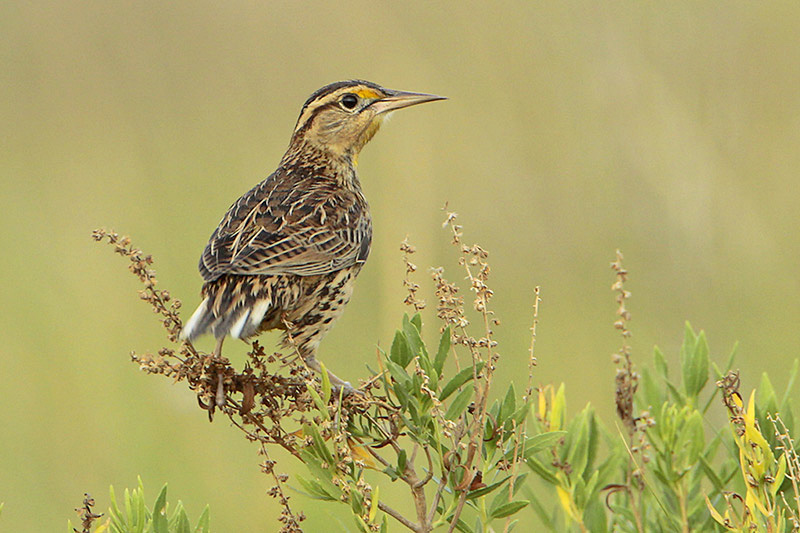Eastern Meadowlarks (Sturnella magna) are medium-sized songbirds with distinctive yellow underparts and a black V-shaped breastband.
They inhabit open grasslands, meadows, and agricultural fields in eastern and central North America where they forage on the ground for insects and small invertebrates. Here is some useful information about these common birds.
On this page
Identification
Eastern Meadowlarks are medium-sized, measuring 7.5-11 inches long with a wingspan of 14-16 inches. They have a stocky build with a rounded body, rounded wings, fairly long legs, and a short tail. Their light gray bills are long and slender, slightly spear-like, and their eyes are dark brown.

Male and female Eastern Meadowlarks share the same appearance; only females are smaller. Their upperparts are pale brown with darker brown and black streaks, while the underparts are yellow with a black V-shaped breastband. They have tan flanks with black streaking and a yellow throat.
Their heads are dirty white with a dark cap, dark stripe from their eye, and small yellow eyebrows. If you see them in flight, you can see that their dark wings are barred, their tail is brown with darker streaks and barring, and the outer tail feathers are white.
Non-breeding and juvenile Eastern Meadowlarks are duller and browner compared to adults. Areas that are usually whitish in adults are buff, the V-band is paler, and their yellow underside appears paler as well.
Vocalizations
The song of the Eastern Meadowlark is a beautiful, flute-like melody that carries over long distances. It consists of a series of 3-5 clear, whistled notes, often described as a series of slurred, descending whistles.
The song may include trills, gurgles, and various musical phrases, creating a distinctive and pleasant overall melody. They are known to sing from elevated perches like fence posts or shrubs.
Eastern Meadowlarks give a series of weet calls when in flight. They also emit simple high-pitched notes to keep in contact. When startled, they may emit a sharp dzert sound but when they feel threatened, they warn others of potential danger by chattering harshly for a second or two.
Food
Eastern Meadowlarks are primarily insectivores, and their diet includes a variety of insects such as beetles, grasshoppers, crickets, caterpillars, ants, true bugs, and spiders. They may also feed on small invertebrates like snails and earthworms.
While insects make up the majority of their diet, Eastern Meadowlarks can also be opportunistic feeders, consuming seeds, grains, and small wild fruits when insects are less abundant.
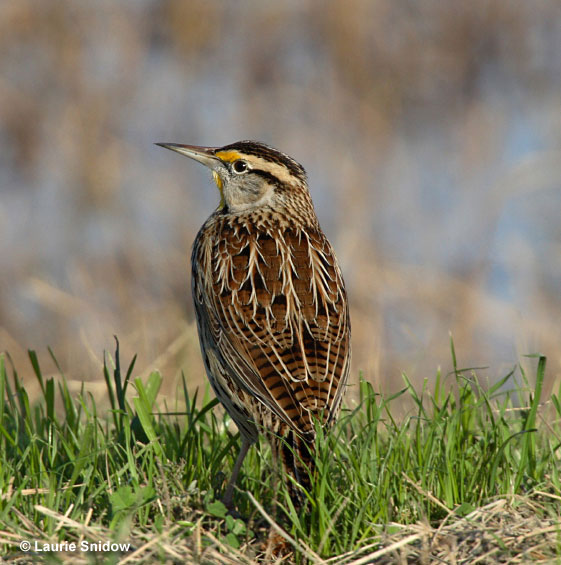
They forage alone or in pairs, especially during the breeding season but congregate in loose flocks during the non-breeding season. These birds are ground foragers, and they feed by walking, hopping, or running through grasslands and meadows, using their stout, pointed bills to probe and pick at the ground. They often prefer areas with low vegetation and scattered shrubs, which provide some degree of protection.
Nesting and Eggs
Male Eastern Meadowlarks arrive on the breeding grounds before females and establish and defend their territories by singing. Females then pick a mate by choosing a territory they like. Males may accept up to three females in their territory. The bond is established by aerial chases, the male displaying to the female, and the copulating.
After that, the female looks for a nesting site, which is usually a small depression in the ground that is concealed by dense vegetation.
Eastern Meadowlark nests are cup-shaped structures made of grasses and stems, lined with finer materials like fine grasses and feathers. The nests may also be domed with an entrance on the side.
One female may have one to two broods in a year with 2-7, mostly 3-5 eggs in a clutch. Eastern Meadowlark eggs are white with variable dark spotting, measuring 0.9-1.2 inches long and 0.7-0.9 inches wide. The mother bird incubates the eggs alone for 13-16 days.
Her mate helps her feed the offspring, but the brunt of the work falls on the female. Younglings leave the nest at around 10-12 days old, but do not become independent for another two weeks.
Current Situation
Eastern Meadowlarks range throughout the eastern United States, Central America, and northern South America. They are resident throughout most of their range except they fly southward from the northernmost areas for the winter.

As their name suggests, Eastern Meadowlarks prefer to inhabit all types of open grassland-type habitats. This includes pastures, hay fields, roadsides, golf courses, overgrown fields, meadows, prairies, and even arid desert grasslands.
Although Eastern Meadowlarks have a huge population of 37 million, then they are listed as near threatened on the IUCN Red List.
This is because their population is in a fairly steep decline and if it continues at this rate, then in less than 20 years it will be halved. They are threatened by land degradation, pesticides, and nest destruction and disturbance.
Facts
- The Eastern Meadowlark has at least 14 recognized subspecies. Three of them live in North America.
- Even though they are called meadowlarks, they are actually blackbirds.
- Eastern and Western Meadowlarks, although very similar, refuse to share any land and are likely to fight each other for territory where their ranges overlap. Usually, so similar species hybridize rather often, but in this case, they only mate where the ranges overlap and there are no mates from the same species.
- Eastern Meadowlarks have an average expected lifespan of five years. The oldest Eastern Meadowlark on record lived to be at least 8 years and 8 months old.
Similar Species
Eastern Meadowlarks look nearly identical to Western Meadowlarks and have a few other fairly similar species as well. Here are the three most similar ones and how to tell which one is which.
Western Meadowlark
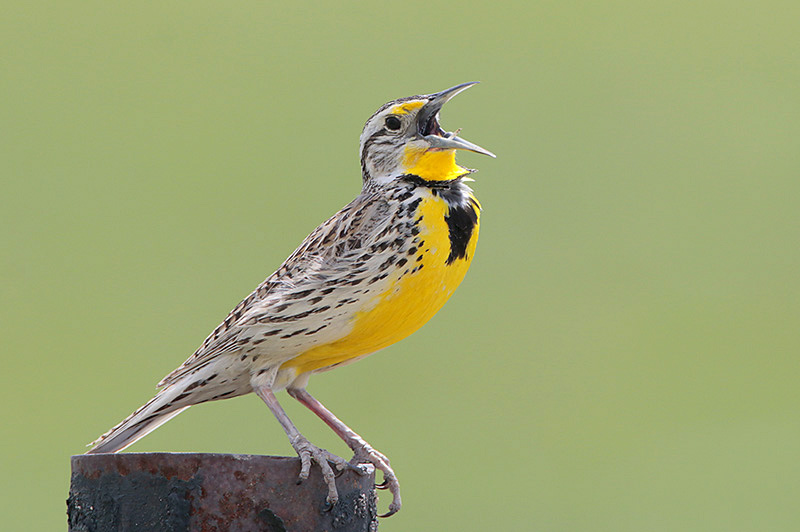
Western Meadowlarks range throughout western North America which extends quite far to the east. Adults have patterned buff, brown, and black upperparts, pale flanks with streaking, yellow undersides with a black V-band across the chest, yellow throat, and a white head with a dark stripe from the eye and a dark cap. Young birds look similar but are duller, buffer all over, and have less yellow and the V-band on their chest is faint brown.
Breeding adults are very similar to each other, and you can only tell the difference between them by their range. Where their ranges overlap, take a very close look at their heads. Eastern Meadowlarks have a white mustache stripe going from their lower bill mandible whereas Western Meadowlarks have a yellow one.
Bobolink
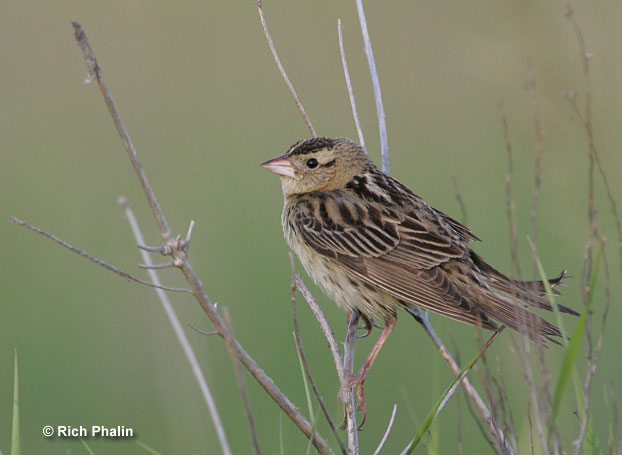
Non-breeding plumage
Bobolinks breed in northeastern North America with their range bleeding into the western areas, especially in Canada. They migrate to South America for the winter. Male Bobolinks are mostly black with white markings above and a yellowish patch at the back of their heads. Females are buffy and brown with darker brown streaking on the back, flanks, and crown. They have a dark eye stripe and pinkish bills.
Breeding males of the two species are very different but females and nonbreeding males may offer an identification challenge. They are most similar to nonbreeding Eastern Meadowlarks as they both have a buffy upperside with darker patterning, a buffy head with a dark eye stripe, and a dark cap. However, female Bobolinks don’t have any yellow in their plumage and their bills are short and pinkish instead of long and gray.
Savannah Sparrow
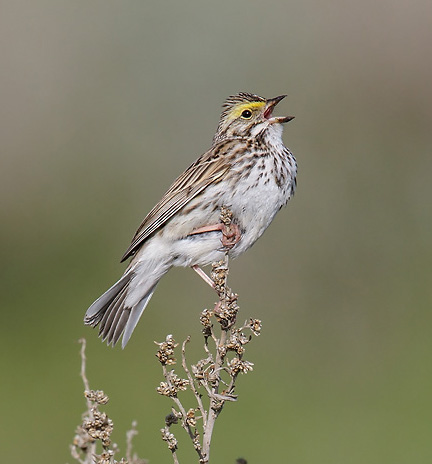
Savannah Sparrows have a broader range, covering North America and extending into Central America. Adults have buffy upperparts and flanks with dark streaking. Their undersides are pale with brown streaks on the chest.
Although similar at a glance, once you get a closer look it should be easy to tell these two apart. Savannah Sparrows are smaller and less colorful. Their undersides are whitish instead of yellow, they don’t have the black V-band across their chest, and their bills are very short and pinkish instead of long and gray.
Frequently Asked Questions
How do I identify an Eastern Meadowlark?
You can identify an Eastern Meadowlark by its medium-sized stocky build, distinctive yellow underparts with a black V-shaped breastband, and brown-streaked upperparts.
Where do Eastern Meadowlarks live?
Eastern Meadowlarks inhabit open grasslands, meadows, pastures, and agricultural fields in the eastern and central United States.
What is the difference between an Eastern and Western Meadowlark?
Eastern and Western Meadowlarks mainly inhabit eastern and western North America respectively. Eastern Meadowlarks have a white mustache stripe whereas Western Meadowlarks have a yellow one.
Are meadowlarks true larks?
Meadowlarks are not true larks, they belong to the Icteridae family that includes birds such as orioles and blackbirds.

